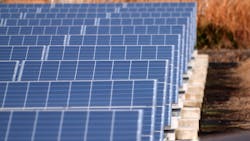SunPower, the second largest solar company in the United States, said that it has struck a new benchmark for solar panel efficiency, beating the record it set only four months ago using similar technology.
The prototype solar panel converts 24.1% of the sunlight that hits it into electricity, a significant step above conventional panels, most of which are between 15% and 18% efficient. According to the National Renewable Energy Laboratory, which tested the module and keeps the record charts, it is the most efficient ever made from monocrystalline silicon—the most common material used to make solar cells.
The new module is composed of individual solar cells that are slightly more efficient than the entire panel. Most solar research has focused on the cell level, but attempts to make them into panels are fraught with high costs and design challenges. Scientists have made individual solar cells almost twice as efficient as SunPower's module, but most are gathering dust on laboratory shelves.
Boosting efficiency has always been on the solar industry’s checklist, but recent efforts have taken a backseat to expanding operations and building out infrastructure. SunPower, though, takes pains to highlight efficiency in its marketing. The company says that solar panels with 15% efficiency generate only half the electricity of its X-series panels, which are 21.5% efficient.
“With greater efficiency, we can fit more watts on the roof,” Peter Cousins, SunPower’s senior vice president of research and development, said in a statement. With higher efficiency, solar panels can produce more electricity in a smaller area, driving down production costs.
Other companies are taking an aggressive stance on efficiency, too. SolarCity, the largest solar provider in the United States, has built modules with 22% efficiency and revealed plans to start making them at its flagship facility in Buffalo, N.Y., which is still under construction.
Typical solar cells consist of a thin layer of silicon treated with chemicals to produce electricity when sunlight shines on it. Narrow wires embedded on the front of the cell, usually made of silver, collect the energy. The circuit is completed with a back plane of aluminum.
SunPower’s modules are based on special Maxeon solar cells, which contain slight tweaks to the traditional design. The basic cell is the same, but the silver wiring is replaced with an electrode material, which has poorer electrical characteristics but covers the entire front of the panel. Without the wiring, more sunlight filters into the cell, while mirrors underneath reflect diffused light into the electrode, further improving efficiency.
Maxeon has fueled several SunPower records. In February, solar panels from the company’s X series reached 22.8% efficiency in tests confirmed by the National Renewable Energy Laboratory. Those panels, which SunPower said are in production, held the record until the latest prototype.
In the laboratory, more complex designs on the cell level can be vastly more efficient. Earlier this year, NREL scientists built a multi-junction cell, which combines two layers of silicon crystals, that converts 29.8% of sunlight into electricity. In 2014, before it ended research on the design, France’s Soitec tested a multi-junction device with 46% efficiency, using mirrors to concentrate the sunlight into intense beams.
But efficiency is not always everything, and certain solar cells have struggled to translate into full-blown panels. Their complex structures and high manufacturing costs keep multi-junction cells off the average person’s home. Crystalline silicon is far more affordable, though SunPower uses more expensive materials and construction methods to make its cells.
SunPower is a slightly unusual solar company in other ways. It has expanded more slowly than its competitors and in previous years generated profits in a struggling industry. In the first quarter of 2016, however, its losses swelled to $85.4 million, up from $9.6 million a year earlier—at least in part linked to huge investments in California and Nevada power plants.
Rivals including SolarCity have been pouring money into new infrastructure, building losses in the pursuit of fast growth. Tesla's recent buyout offer for SolarCity is widely speculated to be an attempted bailout by Elon Musk, the primary shareholder in both companies. In recent months, other solar companies, including SunEdison and Spain's Abengoa, have declared bankruptcy.
SunPower stressed that its latest module will eventually leave the laboratory. Cousins declined to reveal when the new panels might be available, but he said that in the meantime the company would continue testing. In a blog post, he said that “new cell designs will keep pushing laboratory results higher, even above 26 percent.”
Looking for parts? Go to SourceESB.
About the Author
James Morra
Senior Editor
James Morra is the senior editor for Electronic Design, covering the semiconductor industry and new technology trends, with a focus on power electronics and power management. He also reports on the business behind electrical engineering, including the electronics supply chain. He joined Electronic Design in 2015 and is based in Chicago, Illinois.

